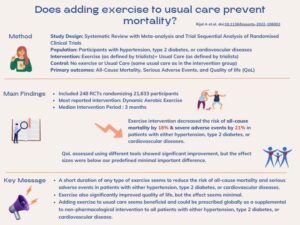Keywords: exercise, mortality, quality of life
The short answer is yes! In this blog we discuss our recent study published in British Journal of Sports Medicine on the effects of adding exercise to usual care in patients with hypertension, type 2 diabetes or cardiovascular diseases (1).
Why is this study important?
Hypertension, type 2 diabetes, and cardiovascular disease are leading non-communicable diseases. Despite evidence-based treatment and management strategies, the control of these diseases is suboptimal. Exercise is a simple and relatively cheap intervention recommended for people with hypertension, type 2 diabetes, or cardiovascular disease. The previous evidence on prevention of mortality have been underpowered and inconclusive (2).
This review is important as it is first of its kind to include all forms of exercise and to consider both risks of systematic errors and random errors.
How did the study go about this?
We systematically searched and screened a potential of 23,000 studies extracted from different databases up to July 2020. We used meta-analysis and Trial Sequential Analysis of randomised clinical trials (RCTs) assessing the effect of adding any form of trialist defined exercise to usual care (as defined by trialist -routine care received by the patients) versus usual care (same usual care as in the intervention group). We included RCTs irrespective of setting, trial duration, publication status, publication year and language. Five independent reviewers extracted data and assessed risk of bias in pairs. The review was conducted based on Preferred Reporting Items for Systematic Reviews and Meta-Analysis. We used Grading of Recommendations Assessment, Development and Evaluation to assess the certainty of the evidence and risk of bias was assessed Cochrane Risk of Bias-version 1.
The primary outcomes were all-cause mortality, serious adverse events, and quality of life.
What did the study find?
We analyzed 248 RCTs randomizing 21,633 participants. The major type of exercise reported was dynamic aerobic exercise (126/248) followed by combined aerobic and resistance exercise (58/248). The majority of the study participants had cardiovascular disease (189/248) followed by type 2 diabetes (41/248) and hypertension (16/248). The median intervention period was 3 months (IQR: 2-4 months) and median follow-up period was 6 months (IQR:3-8 months).
We found that a short duration of any type of exercise reduced the risk of all-cause mortality by 18% and serious adverse events by 21%.
We performed several subgroup analyses and found that the result was independent of type and length of exercise, type of underlying disease, and economic region where the trials originated from (i.e. high income countries vs low- and middle income countries).
We also found that adding exercise to usual care improved quality of life significantly measured via SF36 Mental component, SF36 Physical Component, MLHFQ and Barthel Index of Activity of Daily Living. However, the improvement in most of the scales were below the predefined minimal important differences so the effect may be of questionable clinical relevance.
What are the key take-home points?
- A short duration of any type of exercise seems to reduce the risk of all-cause mortality and serious adverse events in patients with either hypertension, type 2 diabetes, or cardiovascular diseases.
- Exercise also significantly improved quality of life, but the effect seems minimal.
- Our results show that adding exercise to usual care seems to be beneficial and could be prescribed globally as a supplemental to non-pharmacological intervention to all patients with either hypertension, type 2 diabetes or cardiovascular disease.

Contributors:
Anupa Rijal 1,2
Prof. Michael Hecht Olsen 1,2
Prof. Janus Christian Jakobsen 1,3
- Department of Regional Health Research, University of Southern Denmark, Odense, Denmark
- Department of Internal Medicine, Holbaek Hospital, Holbaek, Denmark
- Copenhagen Trial Unit, Centre for Clinical Intervention Research, Copenhagen University Hospital – Rigshospitalet, Copenhagen, Denmark
References:
(1) Rijal A, Nielsen EE, Adhikari TB, et al. Effects of adding exercise to usual care in patients with either hypertension, type 2 diabetes or cardiovascular disease: a systematic review with meta-analysis and trial sequential analysis. British Journal of Sports Medicine. 2022:bjsports-2022-106002. doi:10.1136/bjsports-2022-106002
(2) Rijal A, Nielsen EE, Hemmingsen B, et al. Adding exercise to usual care in patients with hypertension, type 2 diabetes mellitus and/or cardiovascular disease: a protocol for a systematic review with meta-analysis and trial sequential analysis. Syst Rev. 2019/12/17 2019;8(1):330. doi:10.1186/s13643-019-1233-z